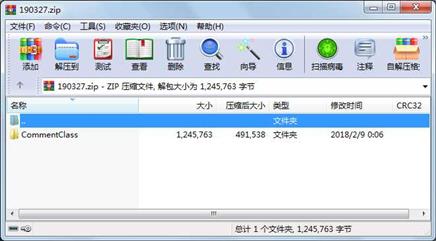-
大小: 481KB文件类型: .zip金币: 2下载: 0 次发布日期: 2021-06-04
- 语言: Python
- 标签: Tensorflow
资源简介
是按照demo来运行的,其中遇到了不少的错误,一一修改后得到的可运行版本,里面已经包含了数据源,开发环境是python3.5.2+Tensorflow1.5.0,亲测可用

代码片段和文件信息
import numpy as np
import tensorflow as tf
import random
import pickle
from collections import Counter
import nltk
from nltk.tokenize import word_tokenize
“““
‘I‘m super man‘
tokenize:
[‘I‘ ‘‘m‘ ‘super‘‘man‘ ]
“““
from nltk.stem import WordNetLemmatizer
“““
词形还原(lemmatizer),即把一个任何形式的英语单词还原到一般形式,与词根还原不同(stemmer),后者是抽取一个单词的词根。
“““
pos_file = ‘pos.txt‘
neg_file = ‘neg.txt‘
# 创建词汇表
def create_lexicon(pos_file neg_file):
lex = []
# 读取文件
def process_file(f):
with open(pos_file ‘r‘) as f:
lex = []
lines = f.readlines()
#print(lines)
for line in lines:
words = word_tokenize(line.lower())
lex += words
return lex
lex += process_file(pos_file)
lex += process_file(neg_file)
#print(len(lex))
lemmatizer = WordNetLemmatizer()
lex = [lemmatizer.lemmatize(word) for word in lex] # 词形还原 (cats->cat)
word_count = Counter(lex)
#print(word_count)
# {‘.‘: 13944 ‘‘: 10536 ‘the‘: 10120 ‘a‘: 9444 ‘and‘: 7108 ‘of‘: 6624 ‘it‘: 4748 ‘to‘: 3940......}
# 去掉一些常用词像thea and等等,和一些不常用词; 这些词对判断一个评论是正面还是负面没有做任何贡献
lex = []
for word in word_count:
if word_count[word] < 2000 and word_count[word] > 20: # 这写死了,好像能用百分比
lex.append(word) # 齐普夫定律-使用Python验证文本的Zipf分布 http://blog.topspeedsnail.com/archives/9546
return lex
lex = create_lexicon(pos_file neg_file)
#lex里保存了文本中出现过的单词。
# 把每条评论转换为向量 转换原理:
# 假设lex为[‘woman‘ ‘great‘ ‘feel‘ ‘actually‘ ‘looking‘ ‘latest‘ ‘seen‘ ‘is‘] 当然实际上要大的多
# 评论‘i think this movie is great‘ 转换为 [01000001] 把评论中出现的字在lex中标记,出现过的标记为1,其余标记为0
def normalize_dataset(lex):
dataset = []
# lex:词汇表;review:评论;clf:评论对应的分类,[01]代表负面评论 [10]代表正面评论
def string_to_vector(lex review clf):
words = word_tokenize(line.lower())
lemmatizer = WordNetLemmatizer()
words = [lemmatizer.lemmatize(word) for word in words]
features = np.zeros(len(lex))
for word in words:
if word in lex:
features[lex.index(word)] = 1 # 一个句子中某个词可能出现两次可以用+=1,其实区别不大
return [features clf]
with open(pos_file ‘r‘) as f:
lines = f.readlines()
for line in lines:
one_sample = string_to_vector(lex line [10]) # [array([ 0. 1. 0. ... 0. 0. 0.]) [10]]
dataset.append(one_sample)
with open(neg_file ‘r‘) as f:
lines = f.readlines()
for line in lines:
one_sample = string_to_vector(lex line [01]) # [array([ 0. 0. 0. ... 0. 0. 0.]) [01]]]
dataset.append(one_sample)
#print(len(dataset))
return dataset
dataset = normalize_dataset(lex)
random.shuffle(dataset)
“““
#把整理好的数据保存到文件,方便使用。到此完成了数据的整理工作
with open(‘save.pickle‘ ‘wb‘) as f:
pickle.dump(dataset f)
“““
# 取样本中的10%做为测试数据
test_size = int(len(dataset) * 0.1)
dataset = np.array(dataset)
train_dataset = dataset[:-test_size]
test_dataset = dataset[-test_size:]
# Feed-Forward Neural Network
# 定义每个层有多少‘神经元‘‘
n_input_layer = len(lex) # 输入层
n_layer_1 = 1000 # hide layer
n_layer_2 = 1000 属性 大小 日期 时间 名称
----------- --------- ---------- ----- ----
目录 0 2018-02-08 16:06 CommentClass\
文件 6160 2018-02-08 15:57 CommentClass\tesww.py
文件 626757 2018-02-08 14:50 CommentClass\pos.txt
文件 612846 2018-02-08 14:50 CommentClass\neg.txt
- 上一篇:sniffer_get_body.py
- 下一篇:python读取wav时频谱绘制
相关资源
- DeepLabV3-Tensorflow-master
- 基于TensorFlow实现CNN文本分类实验指导
- tensorflow2.0 yolo3目标检测算法
- tensorflow制作自己的灰度图像数据集并
- anaconda下安装tensorflow(注:不同版本
- 北京大学曹健老师-人工智能实践:
- Deep Learning With Python - Jason Brownlee
- Python-自然场景文本检测PSENet的一个
- Python-高效准确的EAST文本检测器的一个
- Python-TensorFlow弱监督图像分割
- Python-基于tensorflow实现的用textcnn方法
- Python-subpixel利用Tensorflow的一个子像素
- 【官方文档】TensorFlow Python API docume
-
tensorflow画风迁移代码 st
yle transfer - 简单粗暴 TensorFlow
- [PDF] Reinforcement Learning With Open AI Tens
- tensorflow目标检测代码
- 基于Python的手写字体识别系统
- 基于Tensorflow的人脸识别源码
- python TensorFlow 官方文档中文版
- Python-在TensorFlow中实现实现图像卷积网
- tensorflow-1.9.0-cp37-cp37m-win_amd64.whl
- Faster-RCNN-TensorFlow-Python3.5-master
- 聊天机器人tensorflow
- caffe模型转化为tensorflow模型
- Python-一个非常简单的BiLSTMCRF模型用于
- Python-Tensorflow仿AlphaGo框架实现的AI围棋
- Mask R-CNN源码(TensorFlow版本)
- 基于python3 tensorflow DBN_and_RNN的实现
- tensorflow-0.8.0-cp34-cp34m-linux_x86_64.whl
 川公网安备 51152502000135号
川公网安备 51152502000135号
评论
共有 条评论